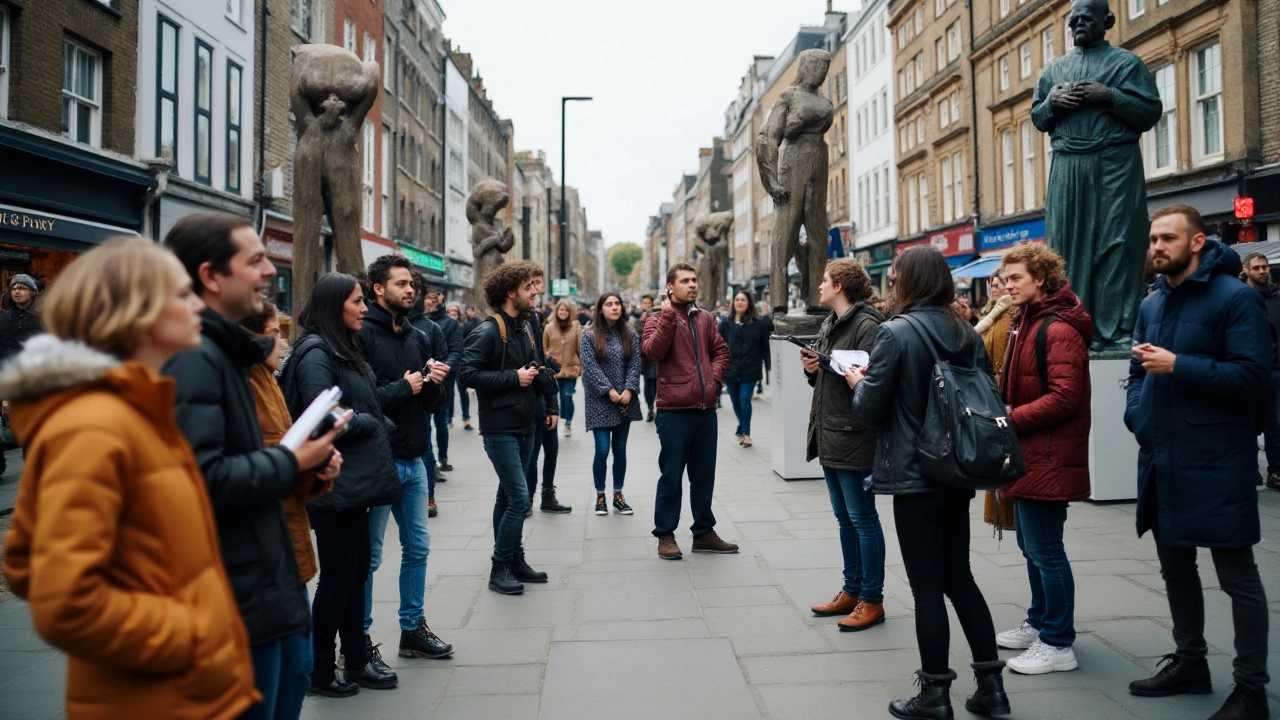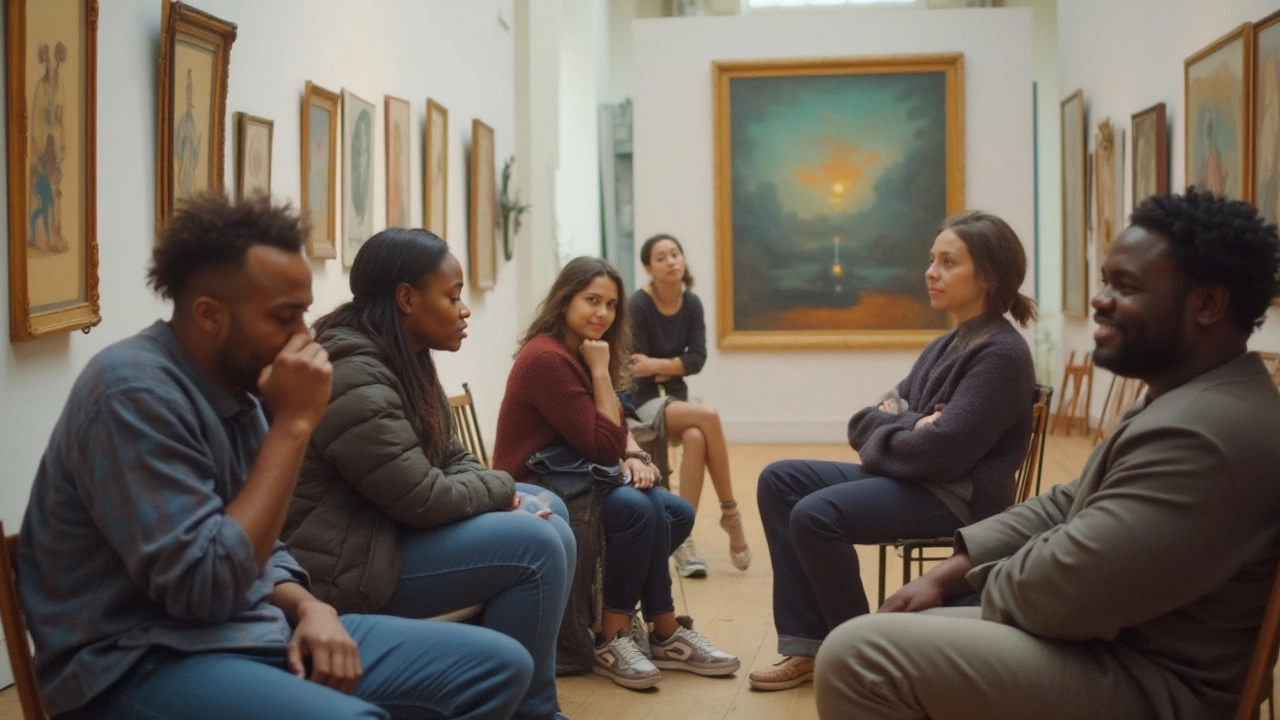Contemporary art can feel like a riddle wrapped in a mystery for those unfamiliar with its nuances. Unlike art from the past, which often adheres to recognizable forms and techniques, contemporary pieces are known for their diversity and unpredictability. This unpredictability challenges viewers to stretch their imaginations and question the norms of what art should be.
Artists today push boundaries, utilizing new technologies and unconventional materials, which can be both thrilling and perplexing. By exploring how contemporary art reflects today's world, we open ourselves to broader perspectives, diverse cultures, and new ways of thinking.
- Defining Contemporary Art
- Breaking Down Barriers in Perception
- The Role of Context in Interpretation
- Embracing Abstract Concepts
- Tips for Appreciating Contemporary Art
Defining Contemporary Art
Contemporary art, a vibrant and multifaceted realm of creativity, spans roughly from the late 20th century to the present. Unlike periods that defined themselves through collective movements or distinct styles, contemporary art stands out for its sheer diversity. It resists constraint, floats with the times, and thrives on innovation. As a reflection of a rapidly changing world, it encompasses a broad range of approaches, beliefs, and techniques, making it uniquely challenging to pin down to one definition. This makes contemporary art feel incredibly free, yet paradoxically hard to grasp for some who look to easily categorize art.
The tag "contemporary" itself indicates relevance to the current era. It is not a cohesive movement but rather a collection of eclectic expressions that often intersect with technology, politics, identity, and global issues. This era encourages artists to break beyond conventional forms, urging them to explore digital mediums, performance art, installations, and interactive works. For instance, artists like Yayoi Kusama play with perspective and repetition, creating immersive environments that challenge how we perceive space and our place within it.
There is a certain beauty in the ambiguity and exploratory nature of contemporary art. As Glenn O'Brien once said,
"Modernism is about space, postmodernism is about communication. You should do what turns you on."This quote highlights contemporary art's emphasis on dialogue over rigid forms. Often, these pieces don't dictate a single narrative but invite viewers to engage in a personal reflection, encouraging multiple interpretations. This fluidity might feel difficult but is central to the contemporary experience.
Traditionally, art was bound by the academy and its canon, but contemporary creators are free from these chains. Artists like Ai Weiwei use their work as a loudspeaker for social justice, combining art with activism by leveraging installations and powerful symbols to elicit responses and spark conversation. This democratization of art can be traced back to major global exhibitions and biennales, where the cross-pollination of ideas from different cultures and disciplines happens on a grand scale. In the digital age, online platforms extend such dialogues further, challenging geographical and cultural borders.
Contemporary art continues to redefine engagement and interaction. A visit to a gallery might present a viewer with a sculpture made from recycled plastics, meant to echo environmental concerns, alongside a digital video installation exploring virtual realities. The diversity of these artistic expressions speaks to the very essence of what contemporary art seeks to embody—an ongoing, evolving conversation about humanity's relationship with the world. This interplay between various forms and messages enriches the tapestry of modern creativity, inviting endless curiosity and discussion.
Breaking Down Barriers in Perception
In the intriguing world of contemporary art, the greatest challenges often stem from our ingrained perceptions and preconceived notions. These barriers, carefully constructed over years of exposure to more traditional art forms, can obscure our understanding of the innovative and sometimes bewildering creations displayed today. The twists and turns contemporary art takes are like a labyrinth, inviting us to get lost and discover what lies at our core. This art form challenges the viewer by breaking away from conventions and questioning the societal norms we are conditioned to accept. It creates a dialogue, urging viewers to interrogate their assumptions and perceive the world through a novel lens that's often unfamiliar and uncomfortable. As we reflect on an artwork's intention, its social commentary, or its defiance of reality, we must allow our minds to shift from the realm of the familiar into the unexplored territories of thought and emotion.
Part of breaking down these barriers involves shedding the notion that art must always evoke beauty or depict reality. Consider works like Damien Hirst's "The Physical Impossibility of Death in the Mind of Someone Living," a shark suspended in formaldehyde. This provocative piece blurs the line between life and death, inviting viewers to grapple with mortality and the transitoriness of existence. The emphasis here is not just on aesthetics but on provoking a visceral reaction and inspiring introspection. The piece highlights the essence of abstract art in contemporary times, where comprehension often lies beyond traditional beauty.
Another dimension in breaking these barriers comes from understanding multidimensional themes that dwell within the art. Take Banksy's politically charged street art, which transcends canvas to deliver not just visual, but also societal impact. Such works urge us to confront issues such as environmental degradation, consumerism, and political unrest. The often cryptic style compels viewers to piece together a narrative or consider different interpretations, making every observation unique. It's the raw audacity of addressing uncomfortable truths without sugarcoating them that hooks people, making the art a catalyst for awareness and change. Think of this not as art for art's sake but as art with a profound, impactful dialogue at its heart.
Curiosity and open-mindedness are key tools required to dismantle these perceptual walls. As Marc Chagall once notably reflected,
"If I create from the heart, nearly everything works; if from the head, almost nothing."The essence of this quote lies in approaching contemporary art with the heart—allowing feelings and emotional resonance to guide our understanding. Often, it is the personal connection to a piece that makes it resonate, even if intellectually it remains elusive. This shift from a cerebral to an emotional reception can open doors to a richer appreciation.
It is also worth acknowledging that the barriers we face with contemporary art are not unique to this era. Historical precedents show the same resistance met new ideas across different art movements. Impressionism, for instance, was once met with skepticism for its departure from realism. Similarly, much of today’s contemporary art will someday be accepted into the canon of revered classics. By recognizing this, we recognize the temporary nature of our uncertainty and can embrace contemporary works with a more forgiving perspective. As we engage with these artworks, either through conversations, guided tours, or personal contemplation, we gradually unravel the intention and message, transforming the initial perplexity into a meaningful connection.

The Role of Context in Interpretation
Understanding contemporary art often depends as much on the context as on the piece itself. Context involves the environment in which the art exists, both figuratively and literally. Historically, art has been viewed in the context of its patronage; whether it was commissioned by the church or royalty or driven by an artist's personal struggle, the relationship between the piece and its background provided a key to its interpretation. In the same way, contemporary art requires us to explore the social, political, and personal circumstances surrounding it. The rapid changes in today's world—technological advancements, societal shifts, and political upheavals—act as the backdrop from which many works emerge. This dynamic landscape informs artists, allowing them to critique, reflect, and question the status quo. Knowing the artist's intent and the piece's origin offers a deeper understanding, transforming a seemingly abstract canvas into a dialogue about human experience.
Consider an installation piece that uses recycled materials. Without context, one might merely see a collection of seemingly random objects. However, recognizing that the artist intended to address environmental issues and consumer waste can completely shift the viewer's perception. This interpretative lens allows us to see beyond the surface, unveiling layers of meaning embedded in the work. Context not only enriches our appreciation of art but also connects us to a broader narrative. It's through this connection that art becomes more than a visual experience; it transforms into an intellectual and emotional journey.
An insightful perspective offered by renowned art critic Jerry Saltz suggests, "Art is a way to get in touch with what you don’t know you don’t know." This statement highlights the importance of opening our minds to the unseen and the unheard, embracing context as a tool to traverse the unfamiliar territories of contemporary art.
To truly grasp context, one might consider the gallery space itself. Modern exhibition sites are chosen deliberately, be it a reclaimed warehouse or a sleek urban gallery, the setting complements the themes within the exhibition. The architecture and history of such spaces add another dimension to the understanding of the artworks exhibited. Context here serves not only as a background story but as an active participant in the work's narrative. Engaging with these environments encourages a holistic interaction with the art, deepening comprehension and appreciation.
Engagement with contemporary art often necessitates an understanding of global cultures and histories, blending traditional motifs with modern narratives. For instance, an artist incorporating indigenous symbolism into a modern political critique invites audiences to acknowledge a narrative that crosses generations. This synthesis of the old with the new is a hallmark of contemporary art, where cultural interchange breathes fresh life into age-old stories. The resplendence of contemporary art lies in its ability to dialogue with both its immediate and extended contexts, allowing it to reflect not just personal expression, but collective consciousness as well.
Embracing Abstract Concepts
In the realm of contemporary art, abstract concepts often take center stage, inviting viewers into a world where form, color, and texture hold meanings beyond the literal. The flexible nature of abstract art allows for personal interpretation, challenging viewers to let go of preconceived notions and engage with their senses. Abstract art doesn't simply depict reality; instead, it captures emotions, thoughts, and moments in time, sometimes leaving the viewer with more questions than answers. This kind of art demands a shift from passive observation to active engagement. Understanding it requires a willingness to connect with the essence of a piece, rather than seeking a straightforward narrative.
The beauty of embracing abstract concepts lies in their universality. Consider Wassily Kandinsky, one of the pioneers in abstract art, who believed that art could evoke a spiritual experience. His works were not just about the visual impact; they aimed to evoke the intangible, making them timeless. By removing clear figures and focusing instead on colors and shapes, Kandinsky opened doors to a form of art that spoke directly to the soul. When observing abstract art, one can often find emotional echoes of their inner world reflected in the chaotic interplay of shapes and shades. The same piece might elicit different reactions in different people, suggesting that abstract art is as much about the viewer as it is about the artist. As Jackson Pollock beautifully put it, "Every good painter paints what he is."
For those new to abstract art appreciation, it might help to view the process as an exploration rather than a pursuit of understanding. Start by simply observing without the pressure to 'get it.' Notice the elements that draw your attention – is it a particular color, a surprising texture, or the way different components interact? Then, consider the feelings these elements evoke. There's no right or wrong way to feel about a piece of art, and acknowledging your emotional response is a key part of connecting with it. As you immerse yourself in the abstract, let your thoughts wander. Abstract art often mirrors back the complexities of life itself, with its blend of chaos, harmony, confusion, and clarity.
Despite seeming unapproachable at times, abstract creativity speaks to the universal human experience, tapping into emotions and ideas that we might not immediately recognize. By deliberately removing the safety net of familiar forms, abstract art provides a space where imagination can roam free. Whether it's the swirling energy of a large canvas or the intimate focus of a small piece, there's a compelling space for everyone to find meaning. This engagement offers not just an escape from reality but a deeper understanding of it from a new vantage point. Embracing these abstract concepts is a journey into the uncharted territories of thought and emotion, a reminder of art's ability to transcend the obvious and touch the profound.

Tips for Appreciating Contemporary Art
Appreciating contemporary art might initially feel like a daunting task. However, approaching it with an open mind and a little curiosity can transform the experience into something enriching. To start, it's essential to remember that contemporary art often reflects the personal experiences, cultural issues, and technological advancements of our time. It is not always about beauty or traditional craftsmanship but about the message or concept that lies beneath. Begin by giving yourself permission not to understand everything at first glance. Art is meant to provoke thought and conversation, and different interpretations are not only possible but encouraged. Remember that feeling perplexed or even uncomfortable is a typical reaction when confronted with something new and unfamiliar.
One effective way to cultivate appreciation is by researching the artist and their intentions. Many artists of the modern era have fascinating backgrounds that influence their work. Understanding their motivation can provide a deeper insight into their art. For example, Ai Weiwei's installations often critique social injustices, which makes a more profound impact when one knows about his personal struggles and activism. Another tip is to consider the cultural context. Art is often a reflection of the society in which it was created. Look up the historical, political, or cultural events that might have inspired the artwork. Such knowledge can turn an abstract piece into a vivid narrative.
To fully engage, try to attend exhibitions or art galleries with a friend or fellow art enthusiast. Discuss your impressions and interpretations; often, this dialogue can bring out perspectives you might not have considered on your own. It's also beneficial to revisit the same piece multiple times. Each viewing can reveal something new as your understanding and feelings evolve. Don't forget about the power of technology—many galleries offer virtual tours or apps with interactive content that provide additional layers of information through videos, interviews, and documentary footage.
"Art enables us to find ourselves and lose ourselves at the same time." — Thomas Merton
Another practical tip is learning to appreciate the medium used by the artist. Artists today work with everything from traditional paints to digital media, performance, or even augmented reality. Understanding these mediums can enhance your experience. For instance, experiencing a digital installation requires acknowledging the role of technology and how it blends with art. Experiment with viewing art at different times of the day or in various lighting conditions, which can alter the mood and perception of a piece.
Finally, don't shy away from exploring various art styles. Dive into the diversity of abstract art, conceptual art, installation art, and others. Each style offers unique insights and emotional experiences. Joining art forums or reading contemporary art magazines can also be beneficial. These communities and publications often provide insider information that enriches your appreciation. Remember, the goal is not to become an art expert but to expand your capacity for enjoying the myriad ways in which human creativity manifests.

